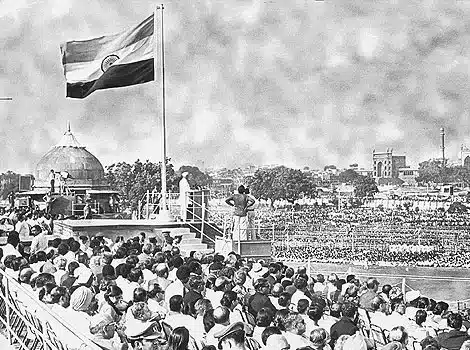The republic of India gained its independence from the rule of the British on 15 August 1947. Since then, every year, 15th August is celebrated as the Independence Day in India to commemorate its freedom from the 200-year-old British government.
For India, 15th August is a day of her re-birth, a new start. At the midnight of 15 August 1947, the British rulers handed the country back to its Indian leaders, ending a remarkable struggle that lasted years. It was 15 August 1947, the historic date, on which sovereign India’s first Prime Minister Pandit Jawaharlal Nehru unfolded the tricolour flag of the nation on the glorious Red Fort. The day is significant in the history of India as bringing an end to British colonial rule in India.
History of Independence Day
In 1757, after the British victory in the Battle of Plassey, the rule of East India Company started in India. By 1858, the British Crown had assumed control over India. The situation after World War I was marked with suppressive and exploitative laws by the British. This led to revolutionary calls for independence and sparked the phase of non-violent and non-cooperation movements followed by the civil disobedience movement.
The enduring leader and a national symbol for all these movements was Mohandas Karamchand Gandhi- the Father of the Nation. The next decades were marked with constant struggles between the Indians and the British for freedom. Many movements and acts were carried out by the Indian National Congress, freedom fighters and the people of India.
In the year 1946, the Labour government, the exchequer of Britain thought of ending their rule over India because of their exhaustion of capital post the World War II. The new viceroy, Lord Mountbatten, advanced the date for the transfer of power, believing the continuous contention between the Congress and the Muslim League might lead to a collapse of the interim government. He chose the second anniversary of Japan’s surrender in World War II, 15 August, as the date of power transfer. The British government announced on 3 June 1947 that it had accepted the idea of partitioning British India into two states; the successor governments would be given dominion status and would have an implicit right to secede from the British Commonwealth. The Indian Independence Act 1947 of the Parliament of the United Kingdom partitioned British India into the two new independent dominions of India and Pakistan with effect from 15 August 1947 and granted complete legislative authority upon the respective constituent assemblies of the new countries. The Act received royal assent on 18 July 1947.
Independence Day Celebrations in India
Every year, India’s Independence Day is celebrated on this day by all the proud Indians. 15th August is observed as a national holiday throughout the country. Though, local governments conduct the ceremony of flag hoisting all over India, the venue of main celebration is the Red Fort in the capital city New Delhi in India. The celebration starts every year with the unfurling of the tricoloured national flag by the Prime Minister of the nation, followed by a televised speech. The speech generally reflects the present condition of the nation along with the achievements in the previous year and the future development plans. A tribute is even paid by the Prime Minister to freedom fighters of India by declaring the day as a national holiday. Post the flag-hoisting ceremony, patriotic programs by children from schools based in different states is one of the main attractions.

